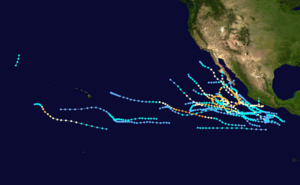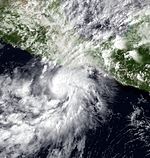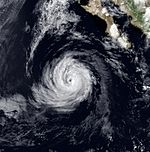1984 Pacific hurricane season
| 1984 Pacific hurricane season | |
|---|---|

Season summary map
|
|
| Seasonal boundaries | |
| First system formed | May 17, 1984 |
| Last system dissipated | November 8, 1984 |
| Strongest storm | |
| Name | Douglas |
| • Maximum winds | 145 mph (230 km/h) (1-minute sustained) |
| Seasonal statistics | |
| Total depressions | 26 |
| Total storms | 21 |
| Hurricanes | 13 |
| Major hurricanes (Cat. 3+) |
7 |
| Total fatalities | 0 |
| Total damage | Unknown |
| Related articles | |
| Tropical storm (SSHWS) | |
| Duration | May 17 – May 21 |
|---|---|
| Peak intensity | 60 mph (95 km/h) (1-min) |
| Category 1 hurricane (SSHWS) | |
| Duration | May 28 – June 18 |
|---|---|
| Peak intensity | 75 mph (120 km/h) (1-min) |
| Category 2 hurricane (SSHWS) | |
| Duration | June 17 – June 26 |
|---|---|
| Peak intensity | 105 mph (165 km/h) (1-min) |
| Category 4 hurricane (SSHWS) | |
| Duration | June 25 – July 6 |
|---|---|
| Peak intensity | 145 mph (230 km/h) (1-min) |
| Category 4 hurricane (SSHWS) | |
| Duration | June 28 – July 9 |
|---|---|
| Peak intensity | 130 mph (215 km/h) (1-min) |
| Tropical depression (SSHWS) | |
| Duration | June 30 – July 2 |
|---|---|
| Peak intensity | 35 mph (55 km/h) (1-min) |
| Category 2 hurricane (SSHWS) | |
| Duration | July 3 – July 10 |
|---|---|
| Peak intensity | 110 mph (175 km/h) (1-min) |
| Category 3 hurricane (SSHWS) | |
| Duration | July 7 – July 14 |
|---|---|
| Peak intensity | 115 mph (185 km/h) (1-min) |
| Tropical depression (SSHWS) | |
| Duration | July 24 – July 25 |
|---|---|
| Peak intensity | 30 mph (45 km/h) (1-min) |
The 1984 Pacific hurricane season was tied for the fourth most active hurricane season on record. The season produced 26 tropical cyclones, of which 21 developed into named storms; 13 cyclones attained hurricane status, of which three reached major hurricane status. The season officially started on May 15, 1984, in the eastern Pacific, and June 1, 1984, in the central Pacific, and lasted until November 30, 1984. These dates conventionally delimit the period of each year when the vast majority tropical cyclones form in the northeastern Pacific Ocean. The strongest hurricane of the season was Hurricane Douglas, which attained Category 4 status on the Saffir-Simpson Hurricane Scale in the open Pacific.
Only four tropical systems made landfall during the season. In September, Hurricane Norbert took an erratic path before making landfall on Baja California as a tropical storm, bringing flooding rains. Hurricane Odile also made landfall on Mexico during September as a tropical storm, killing 21 at sea and severely damaging crops. Additionally, Hurricanes Genevieve and Polo struck Mexico as tropical depressions. Hurricane Douglas also threatened Hawaii.
There were 18 tropical storms in the Eastern Pacific Hurricane Center’s (EPHC) area of responsibility (AOR) this season. Twelve became hurricanes. Of those, six became major hurricanes by reaching Category 3 intensity or higher on the Saffir-Simpson Hurricane Scale. In the Central Pacific Hurricane Center’s (CPHC) AOR, there was a major hurricane and two tropical storms. There was one tropical depression that did not strengthen into a storm.
The first storm of the season formed on May 17 and the last storm disspted on November 5, spanning 173 days. While this was much shorter than 1983, it was still two weeks longer than the 10 year average. During the season, there were a total of 1187 storm hours and 1048 hurricane hours, both of which were well above normal. A total of 585 advisories were issued by the EPHC, nearly 200 above normal.
...
Wikipedia
















